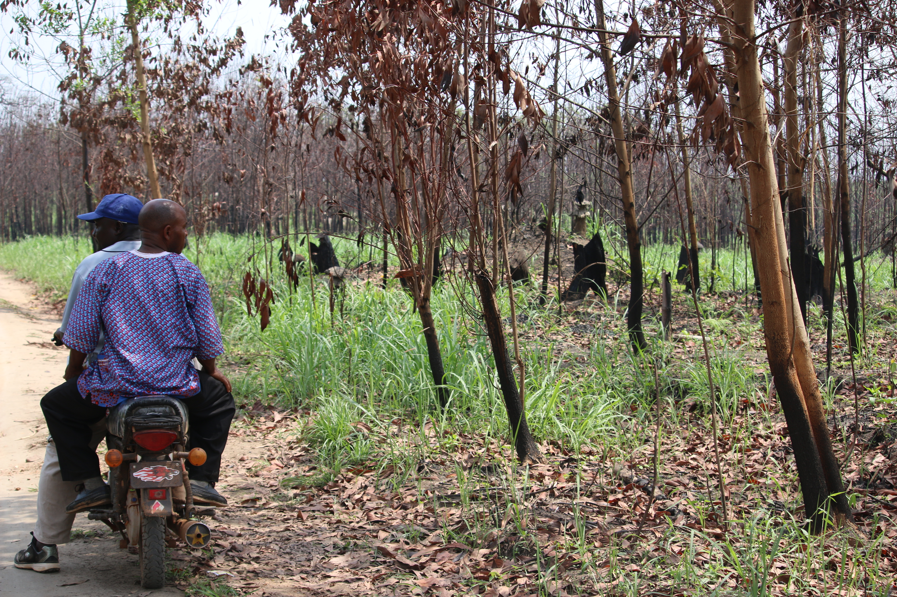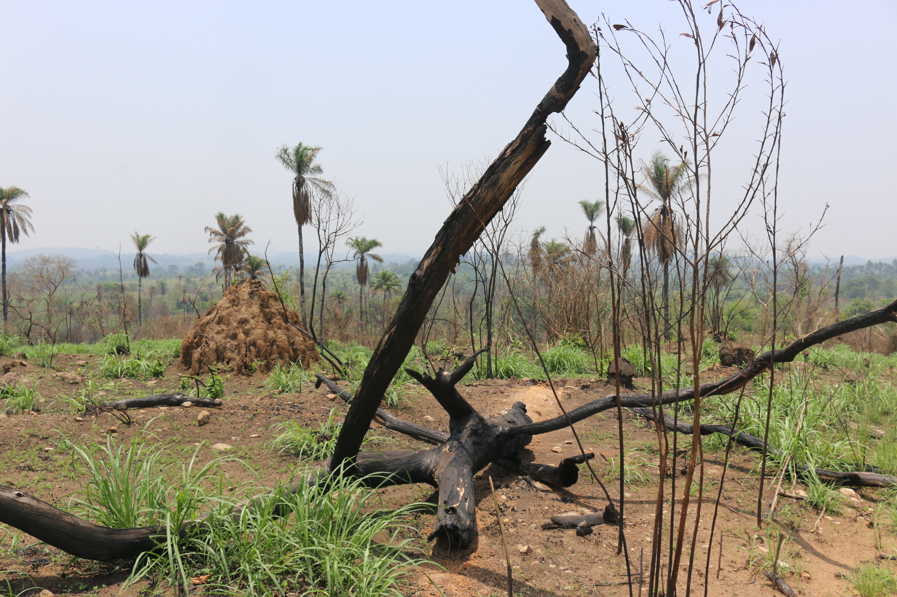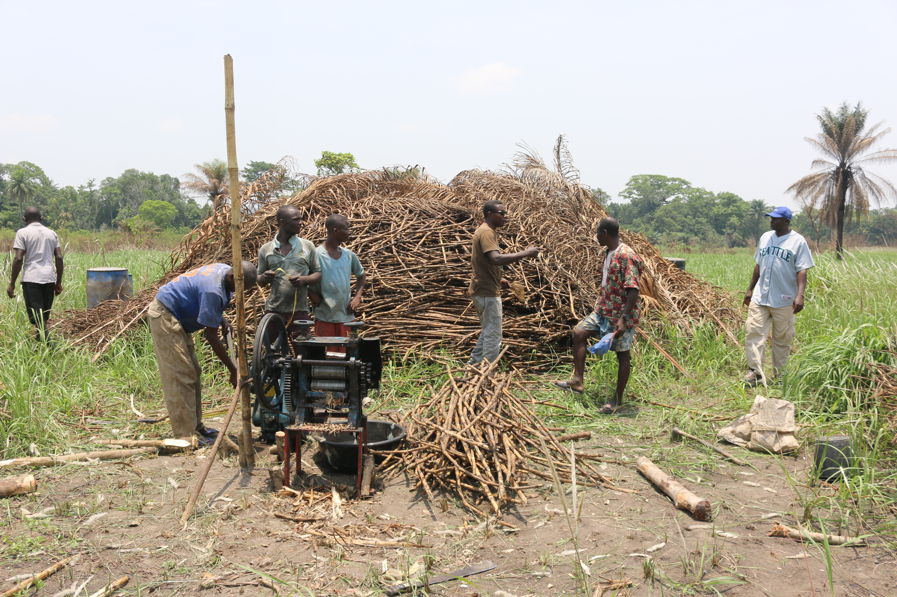
KPANDU, LOFA COUNTY – Andrew Saah Kendema expected a big harvest, not the big fire that swept through his farm and thousands of acres of forest land in the Foya Tengia District of Lofa County in March this year. His sugarcane farm would have fetched him about 20 drums of liquor, enough returns on a US$10,000 severance pay he received from the United Nations Mission in Liberia (UNMIL) and invested in 2016. Now he has to invest additional money into replanting new sugarcane and wait for August next year for a possible harvest.
“It’s like I am just starting again. I am so frustrated,” a visibly downhearted Kendema, 52, tells FrontPage Africa on his farm in Kpandu.
With other farmers who have come to help, Kendema piles the charred sugarcane in bundles and grinds them with an improvised mill. Shoots of fresh, green sugarcane sprout up between the rubble of his flame-ravaged farm.
The forest fire that destroyed Kendema’s farm is not the first in Foya District. Forest fires in this northern part of Liberia, close to both the Guinea and Sierra Leone borders, have been devouring the land for decades, according to local authorities.
“When the wind comes, especially during the peak of the dry season, small wind can cause fire,” explains Moses F. Sonjor, Sr., Foya District’s Assistant Superintendent for Development following a workshop in Monrovia to draft a land use plan for the district. The first measure in the country following the passing into law of the Land Rights Act last year, the Foya land use plan looks at ways to prevent fire outbreaks.
“This is something that has been continuing,” Sonjor says of the fires.
The dry landscape of Foya makes it easy for forest fires to spread. Unlike other places in Lofa County, Foya is covered with savanna grasslands that act as fuel.
An assessment for the draft land use plan done earlier by the Sustainable Trade Initiatives (IDH) of the Netherlands blamed the district’s environmental threat on the grassland, in addition to deforestation and forest degradation. The IDH found that Foya “is at a brink of an irreversible ecological or environmental impotency and disaster.”

Left behind by an Israeli company
A large portion of the savanna grassland in Foya today was left by an Israeli company Agrimenco, according to Sonjor. The company cleared the land for mechanized rice farming and oil palm plantation in the 1970s. Its plantation was taken over by the Liberia Produce Marketing Corporation (LPMC) up to the Liberian Civil War beginning in 1989.
“All the cleared space was not farmed, and as a result, new species of plant started growing, and we dealt away with the forest, which was somehow someway serving as a buffer zone for the wind,” Sonjor says.
Farmers in Kpandu are not the only victims of the forest fire last March. The fire ravaged thousands of acres of farmland and plantation in its path.
Saah Keyo, a 35-year-old farmer in the village next to Kpandu —Kendema (spelled the same as the surname of the farmer in Kpandu) —lost nearly an acre of palm plantation to the fire. Tamba Blessing, the 37-year-old town chief of Kendema lost three acres of palm and cocoa farm. And flames consumed 50 acres of an afforestation plantation of the Forest Development Authority (FDA).
The devastation caused by the fire is visible all around when FrontPage Africa visits in mid-April. Roasted mushroom-shaped anthills and shapeless termite mounds are seen across several acres of lands between Kendema and Kpandu. Not even the scorching sunlight seems bright enough to lift the gloom of the bleak landscape and the blackened bark of leafless trees struggling to survive after the previous month’s blaze. Except for some greenery—predominantly tall palm trees—close to swamps here and there, this place is dead.
Fire ‘Law’
Local authorities in the neighboring villages blame Kpandu for starting the wildfire. Kendema the farmer and other villagers deny any wrongdoing, saying the fire started from Menekoma along the Sierra Leone border and accusing the FDA of not doing anything to halt the rapid spread.
A number of villagers from Kpandu, Kendema and five other communities were held by authorities and investigated over the fire. Following weeks of interrogation, investigators allowed the villagers to leave without any arson charges filed.
Local authorities are finalizing a fire law to address future forest fire outbreaks. Among the restrictions, the draft law prohibits people from igniting charcoal, lighting matches and smoking cigarettes, and burning farms without the knowledge of other villagers. Fines for violators range from L$1,500 and L$5,000, and punishment is up to five months in prison. “All towns in Foya Statutory District are to select two persons from their towns and [a] fireman to work with their town chief,” the first section of the law reads.
“The citizens themselves have agreed on the law, and it is bound to hold,” says Commissioner James Dorngah in a mobile phone interview, adding that all chiefs and elders of the district have agreed to enforce the proposed “law.” It is not clear whether that can be the case without it being created by the National Legislature.
The “Foya Fire Control Law” was first drafted on February 15, 2015, but has not had a smooth sailing.
“It has not actually been effective in the sense that, whenever one violates any of these regulations, it becomes hard to impose penalties,” says Oliver T. Korboi, silviculture officer in charge of Foya Afforestation and Reforestation Project of the FDA. The 5,693-acre plantation combats the fire-fueling savanna. It was established in 2011 as part of a 1986 move by the government of Liberia to curtail Foya’s grassland environmental crisis.
“The most important thing about the fire outbreak is to identify the doer of the act in the absence of the community dwellers,” Korboi says. “This is why we try to engage these community dwellers so that we can all work together.”

Fire Line
In the past, communities worked together to prevent and contain fire outbreaks with communal laws and practices. In addition to prohibition of smoking, striking matches and burning farm or charcoal without the consent of the entire village, residents depended on fire lines. Farmers would clear a huge portion of bush between farmlands and villages, forests and savanna grasslands to contain the spread of wildfire.
Yet Foya is losing its culture of fire prevention and containment, including fire lines, according to Development Superintendent Sonjor.
“Before, a whole town used to cut fire lines, but nowadays individual farmers cut their own fire lines,” Sonjor explains.
Kendema, the farmer in Kpandu, is paranoid over what happened to him in March. He says he does not think that the fire law will be enforced and finds it safer to take fire prevention into his own hands.
“This time, I will not wait for the whole town,” he says. “When I am finished planting my farm, I make sure to cut my fire line.”
Kparlloe Sandikie and Thomas Korpu in Foya contributed to this story
This story was a collaboration with Front Page Africa as part of the Land Rights and Climate Change Reporting Project. Funding is provided by the American World Jewish Service. The funder had no say in the story’s content.
